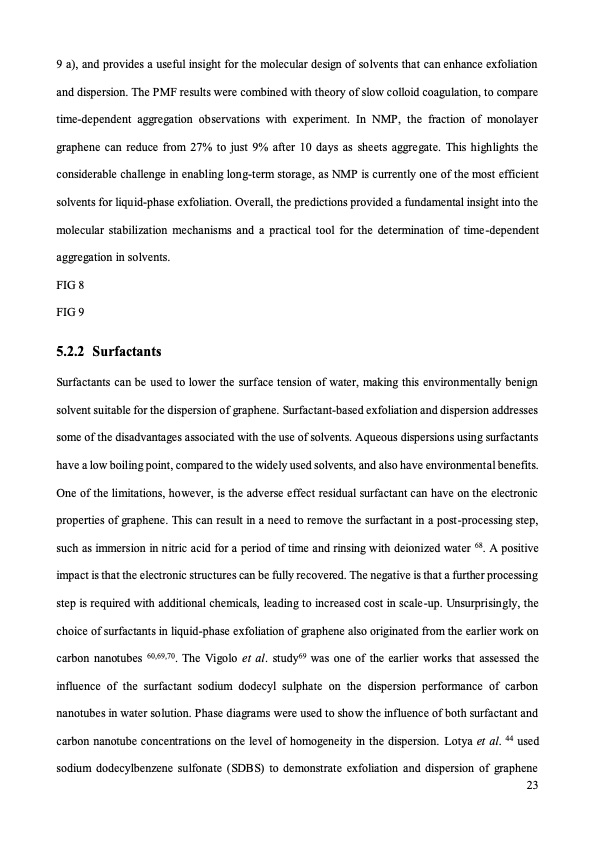
PDF Publication Title:
Text from PDF Page: 023
9 a), and provides a useful insight for the molecular design of solvents that can enhance exfoliation and dispersion. The PMF results were combined with theory of slow colloid coagulation, to compare time-dependent aggregation observations with experiment. In NMP, the fraction of monolayer graphene can reduce from 27% to just 9% after 10 days as sheets aggregate. This highlights the considerable challenge in enabling long-term storage, as NMP is currently one of the most efficient solvents for liquid-phase exfoliation. Overall, the predictions provided a fundamental insight into the molecular stabilization mechanisms and a practical tool for the determination of time-dependent aggregation in solvents. FIG 8 FIG 9 5.2.2 Surfactants Surfactants can be used to lower the surface tension of water, making this environmentally benign solvent suitable for the dispersion of graphene. Surfactant-based exfoliation and dispersion addresses some of the disadvantages associated with the use of solvents. Aqueous dispersions using surfactants have a low boiling point, compared to the widely used solvents, and also have environmental benefits. One of the limitations, however, is the adverse effect residual surfactant can have on the electronic properties of graphene. This can result in a need to remove the surfactant in a post-processing step, such as immersion in nitric acid for a period of time and rinsing with deionized water 68. A positive impact is that the electronic structures can be fully recovered. The negative is that a further processing step is required with additional chemicals, leading to increased cost in scale-up. Unsurprisingly, the choice of surfactants in liquid-phase exfoliation of graphene also originated from the earlier work on carbon nanotubes 60,69,70. The Vigolo et al. study69 was one of the earlier works that assessed the influence of the surfactant sodium dodecyl sulphate on the dispersion performance of carbon nanotubes in water solution. Phase diagrams were used to show the influence of both surfactant and carbon nanotube concentrations on the level of homogeneity in the dispersion. Lotya et al. 44 used sodium dodecylbenzene sulfonate (SDBS) to demonstrate exfoliation and dispersion of graphene 23PDF Image | graphene production via nonoxidizing liquid exfoliation

PDF Search Title:
graphene production via nonoxidizing liquid exfoliationOriginal File Name Searched:
Graphene-R2-review.pdfDIY PDF Search: Google It | Yahoo | Bing
Salgenx Redox Flow Battery Technology: Power up your energy storage game with Salgenx Salt Water Battery. With its advanced technology, the flow battery provides reliable, scalable, and sustainable energy storage for utility-scale projects. Upgrade to a Salgenx flow battery today and take control of your energy future.
| CONTACT TEL: 608-238-6001 Email: greg@infinityturbine.com | RSS | AMP |